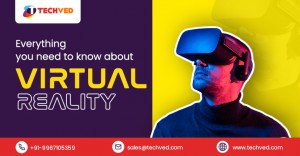Mumbai, Maharashtra Jan 10, 2022 (Issuewire.com) - Virtual Reality has come a long way with its diversified use-cases from effective implementation in the gaming and entertainment industry in the past few years. It has paved its path from education to healthcare, automobile to retail, and many more. And now, the HR department of companies are taking this technology's help to its business to be more effective and flourishing.
Along with the change in technologies and workplace philosophy, the perspective about work-life has changed for the newer generation. For this generation, only the handsome paycheck with stability is not a yardstick, but they also look for career development, flexibility, and a balanced and positive environment in a workspace. Altogether, these criteria matching up to the recruiters' criteria like less attrition rate and hiring the suitable candidates, etc., makes the combination challenging to work out.
Applying VR can ease these crucial points to a great extends and can provide the recruiters an excellent opportunity to enhance the candidates' experience.
What is Virtual Reality: Virtual Reality is a technology that creates an immersive artificial environment digitally. With the help of a headset, you can quickly teleport to a virtual world, and the experience is engaging, and you can also have a sharing experience with others wearing a VR headset.
Today, VR has a significant implication for interactive and collaborative workways in the business world. This article will throw some light on the usability and their benefits on the HR department of any business.
How Virtual Reality is Changing HR:
Virtual Reality is conveniently providing a constructive solution to HR professionals. A recruiting procedure can spend an average of $123. So, it's essential to make up for the cost and hire the best candidates to adhere to company values and required skills. However, the attrition rate from recruitment to onboarding within six months is high. To diminish this effect, VR can be a great help.
Recruiting: With a VR-driven selection process, an organization needn't be limited to a particular place or city. It can interview with an immersive experience throughout the world. The candidates can be interviewed without being traveled to the organization's location.
Onboarding: Lack of information and poor communication can be the two significant aspects of a greater attrition rate due to the created misconception about the workspace. This can be reduced with a virtual tour of the workspace, explaining the vision and mission of the company virtually by the top leadership teams, and a virtual tour to the colleague's desks. Thus, a candidate can know their future workspace and work culture. Toyota has already implemented this model and used VR to show their campus to the new joiners.
Interviewing: A recent survey called 'Survey of Millenials' conducted by LinkedIn reflects the workplace preference of its employees. It shows that an innovative and inspiring workspace be the top factor for recruiting the best talents. VR technology helps the interviewers to understand the candidate better by analyzing their analytical and technical skills. Many companies use VR technology to create an immersive virtual scenario for the candidate and produce a set of multiple-choice questions based on the scene. They can quickly evaluate a candidate's thinking power along with the analytical and other skills by the responses and can decide if the fellow candidate is suitable for a particular position or not.
Training: VR can make tedious activities engaging and interesting. By soft skill training, employees can learn about creativity, empathy, work ethic, communication, adaptability, prevent sexual harassment, identify racial discrimination, etc. VR takes real-life scenarios and recreates realistic interactions in a stress-free, fully immersive environment that brings a new perspective. VR provides complete access to the users. Learners can repetitively access the course from anywhere and anytime with the help of headsets, desktops, or mobile devices until they master the system. Research showed that employees could train 4X faster using VR than the traditional methods. For example, Vantage Point has developed a VR-training platform to provide anti-sexual harassment training to its employees.
Tracking Data: VR can also help track the gender pay gap. Mercer is developing a VR program that'll help women's negotiation power address the gender pay gap.
Limitations:
Migrating to new technology or implementing a new one is always challenging. Most senior HR might not be grown up using these top-notch technologies, and adaptability could be a barrier. In this case, to decrease the gap, the implementation of VR should be experimental and adhere to the business need.
In the End:
Clearly, VR projects a huge potential for Human Resource departments. It is not limited to being a fancy gadget; it's an important business tool that improves the quality and scalability of business, enhances the candidate and employee experience, and is cost-effective. Soon, VR will be a wide application in the HR field of any business.
Written by:
Jay Anthony,
Marketing Head, TECHVED Consulting
Media Contact
TECHVED Consulting tvd.tanvim@gmail.com 022 6132 1000 201, Synergy Business Park, Goregaon, Mumbai, Maharashtra 400063 https://www.techved.com/









